Predictors of Changes in Alcohol Craving Levels during a Virtual Reality Cue Exposure Treatment among Patients with Alcohol Use Disorder
Abstract
:1. Introduction
2. Methods
2.1. Participants
2.2. Measures
2.3. Instruments
2.3.1. Hardware
2.3.2. Software
2.4. Procedure
2.4.1. Randomization
2.4.2. VR-CET Condition
2.4.3. TAU Condition
2.5. Data Analysis
3. Results
4. Discussion
5. Conclusions
Author Contributions
Funding
Acknowledgments
Conflicts of Interest
References
- Van Lier, H.G.; Pieterse, M.E.; Schraagen, J.M.C.; Postel, M.G.; Vollenbroek-Hutten, M.M.R.; de Haan, H.A.; Noordzij, M.L. Identifying viable theoretical frameworks with essential parameters for real-time and real world alcohol craving research: A systematic review of craving models. Addict. Res. Theory 2018, 26, 35–51. [Google Scholar] [CrossRef] [Green Version]
- Tiffany, S.T.; Wray, J.M. The clinical significance of drug craving. Ann. N. Y. Acad. Sci. 2012, 1248, 1–17. [Google Scholar] [CrossRef]
- Drummond, D.C. Theories of drugs craving, ancient and modern. Addiction 2001, 96, 33–46. [Google Scholar] [CrossRef]
- Snelleman, M. Exploring Factors Related to Craving and Relapse in Alcohol-Dependent Outpatients; Erasmus University Rotterdam: Rotterdam, The Netherlands, 2017. [Google Scholar]
- Stohs, M.E.; Schneekloth, T.D.; Geske, J.R.; Biernacka, J.M.; Karpyak, V.M. Alcohol craving predicts relapse after residential addiction treatment. Alcohol Alcohol. 2019, 54, 167–172. [Google Scholar] [CrossRef]
- Sliedrecht, W.; de Waart, R.; Witkiewitz, K.; Roozen, H.G. Alcohol use disorder relapse factors: A systematic review. Psychiatry Res. 2019, 278, 97–115. [Google Scholar] [CrossRef]
- Breese, G.R.; Sinha, R.; Heilig, M. Chronic alcohol neuroadaptation and stress contribute to susceptibility for alcohol craving and relapse. Pharmacol. Therapeut. 2011, 129, 149–171. [Google Scholar] [CrossRef] [Green Version]
- Morean, M.E.; L’Insalata, A.; Butler, E.R.; McKee, A.; Krishnan-Sarin, S. Age at drinking onset, age at first intoxication, and delay to first intoxication: Assessing the concurrent validity of measures of drinking initiation with alcohol use and related problems. Addict. Behav. 2018, 79, 195–200. [Google Scholar] [CrossRef] [PubMed]
- Hintzen, A.K.; Cramer, J.; Karagülle, D.; Heberlein, A.; Frieling, H.; Kornhuber, J.; Bleich, S.; Hillemacher, T. Does alcohol craving decrease with increasing age? Results from a cross-sectional study. J. Stud. Alcohol Drugs 2011, 72, 158–162. [Google Scholar] [CrossRef] [PubMed]
- Rohit, S.R.; Shwetha, R.; Bhat, S. Factor analysis of coping strategies among subjects of alcohol dependence syndrome: A study at tertiary care center. J. Alcohol. Drug Depend. 2017, 5, 1–7. [Google Scholar]
- Petit, G.; Luminet, O.; Cordovil de Sousa Uva, M.; Monhonval, P.; Leclercq, S.; Spilliaert, Q.; Zammit, F.; Maurage, P.; de Timary, P. Gender differences in affects and craving in alcohol-dependence: A study during alcohol detoxification. Alcohol. Clin. Exp. Res. 2017, 41, 421–431. [Google Scholar] [CrossRef]
- Yarmush, D.E.; Manchery, L.; Luehring-Jones, P.; Erblich, J. Gender and impulsivity: Effects on cue-induced alcohol craving. Alcohol. Clin. Exp. Res. 2016, 40, 1052–1067. [Google Scholar] [CrossRef]
- Day, A.M.; Celio, M.A.; Lisman, S.A.; Spear, L.P. Gender, history of alcohol use and number of drinks consumed predict craving among drinkers in a field setting. Addict. Behav. 2014, 39, 1–11. [Google Scholar] [CrossRef] [PubMed] [Green Version]
- Rosoff, D.B.; Clarke, T.K.; Adams, M.J.; McIntosh, A.M.; Smith, G.D.; Jung, J.; Lohoff, F.W. Educational attainment impacts drinking behaviors and risk for alcohol dependence: Results from a two-sample Mendelian randomization study with ~780,000 participants. Mol. Psychiar. 2019, 1–19. [Google Scholar] [CrossRef] [Green Version]
- Cronce, J.M.; Larimer, M.E. Individual-focused approaches to the prevention of college student drinking. Alcohol. Res. Health 2011, 34, 210–221. [Google Scholar]
- Walton, M.A.; Blow, F.C.; Bingham, C.R.; Chermack, S.T. Individual and social/environmental predictors of alcohol and drug use 2 years following substance abuse treatment. Addict. Behav. 2003, 28, 627–642. [Google Scholar] [CrossRef]
- De Sousa Uva, M.C.; Luminet, O.; Cortesi, M.; Constant, E.; Derely, M.; de Timary, P. Distinct effects of protracted withdrawal on affect, craving, selective attention and executive functions among alcohol-dependent patients. Alcohol Alcohol. 2010, 45, 241–256. [Google Scholar] [CrossRef] [Green Version]
- Manchery, L.; Yarmush, D.E.; Luehring-Jones, P.; Erblich, J. Attentional bias to alcohol stimuli predicts elevated cue-induced craving in young adult social drinkers. Addict. Behav. 2017, 70, 14–27. [Google Scholar] [CrossRef]
- Balsamo, D.N.; Douaihy, A.; Cornelius, J.R.; Daley, D.; Kirisci, L.; Hyman, S.M.; Salloum, I.M. Differential impact of depressive and manic mood states on alcohol craving in comorbid bipolar alcoholism: Preliminary findings. Addict. Disord. Their Treat. 2016, 15, 107–112. [Google Scholar] [CrossRef]
- Fatseas, M.; Serre, F.; Swendsen, J.; Auriacombe, M. Effects of anxiety and mood disorders on craving and substance use among patients with substance use disorder: An ecological momentary assessment study. Drug. Alcohol Depend. 2018, 187, 242–248. [Google Scholar] [CrossRef]
- Lane, S.P.; Carpenter, R.W.; Sher, K.J.; Trull, T.J. Alcohol craving and consumption in borderline personality disorder: When, where, and with whom. Clin. Psychol. Sci. 2016, 4, 775–792. [Google Scholar] [CrossRef]
- Simpson, T.L.; Stappenbeck, C.A.; Varra, A.A.; Moore, S.A.; Kaysen, D. Symptoms of posttraumatic stress predict craving among alcohol treatment seekers: Results of a daily monitoring study. Psychol. Addict. Behav. 2012, 26, 724–735. [Google Scholar] [CrossRef] [PubMed]
- Piasecki, T.M.; Jahng, S.; Wood, P.K.; Robertson, B.M.; Epler, A.J.; Cronk, N.J.; Rohrbaugh, J.W.; Heath, A.C.; Shiffman, S.; Sher, K.J. The subjective effects of alcohol-tobacco co-use: An ecological momentary assessment investigation. J. Abnorm. Psychol. 2011, 120, 557–571. [Google Scholar] [CrossRef] [PubMed] [Green Version]
- Cooney, N.L.; Litt, M.D.; Cooney, J.L.; Pilkey, D.T.; Steinberg, H.R.; Oncken, C.A. Alcohol and tobacco cessation in alcohol-dependent smokers: Analysis of real-time reports. Psychol. Addict. Behav. 2007, 21, 277–286. [Google Scholar] [CrossRef] [PubMed] [Green Version]
- Hitschfeld, M.J.; Schneekloth, T.D.; Ebbert, J.O.; Hall-Flavin, D.K.; Karpyak, V.M.; Abulseoud, O.A.; Patten, C.A.; Geske, J.R.; Frye, M.A. Female smokers have the highest alcohol craving in a residential alcoholism treatment cohort. Drug. Alcohol Depend. 2015, 150, 179–182. [Google Scholar] [CrossRef]
- Karriker-Jaffe, K.J.; Subbaraman, M.S.; Greenfield, T.K.; Kerr, W.C. Contribution of alcohol and drug co-use to substance use problems: Data from a nationally-representative sample of US adults who have never been to treatment. Nord. Stud. Alcohol Drugs 2018, 35, 428–442. [Google Scholar] [CrossRef] [Green Version]
- Hallgren, K.A.; Mccrady, B.S.; Epstein, E.E. Trajectories of drinking urges and the initiation of abstinence during cognitive-behavioral alcohol treatment. Addiction 2016, 111, 854–865. [Google Scholar] [CrossRef] [Green Version]
- Law, B.; Gullo, M.J.; Daglish, M.; Kavanagh, D.J.; Feeney, G.F.X.; Young, R.M.; Connor, J.P. Craving mediates stress in predicting lapse during alcohol dependence treatment. Alcohol. Clin. Exp. Res. 2016, 40, 1058–1064. [Google Scholar] [CrossRef]
- Bottlender, M.; Soyka, M. Impact of craving on alcohol relapse during, and 12 months following, outpatient treatment. Alcohol Alcohol. 2004, 39, 357–361. [Google Scholar] [CrossRef] [Green Version]
- Yoon, G.; Kim, S.W.; Thuras, P.; Grant, J.E.; Westermeyer, J. Alcohol craving in outpatients with alcohol dependence: Rate and clinical correlates. J. Stud. Alcohol Drugs 2006, 67, 770–777. [Google Scholar] [CrossRef]
- Litt, M.D.; Cooney, N.L.; Morse, P. Reactivity to alcohol-related stimuli in the laboratory and in the field: Predictors of craving in treated alcoholics. Addiction 2000, 95, 889–900. [Google Scholar] [CrossRef]
- Bujarski, S.; David Jentsch, J.; Roche, D.J.O.; Ramchandani, V.A.; Miotto, K.; Ray, L.A. Differences in the subjective and motivational properties of alcohol across alcohol use severity: Application of a novel translational human laboratory paradigm. Neuropsychopharmacology 2018, 43, 1891–1899. [Google Scholar] [CrossRef] [PubMed]
- MacKillop, J.; Miranda, R., Jr.; Monti, P.M.; Ray, L.A.; Murphy, J.G.; Rohsenow, D.J.; McGeary, J.E.; Swift, R.M.; Tidey, J.W.; Gwaltney, C.J. Alcohol demand, delayed reward discounting, and craving in relation to drinking and alcohol use disorders. J. Abnorm. Psychol. 2010, 119, 106–114. [Google Scholar] [CrossRef] [PubMed]
- Wapp, M.; Burren, Y.; Znoj, H.; Moggi, F. Association of alcohol craving and proximal outcomes of a residential treatment program for patients with alcohol use disorders. J. Subst. Use 2015, 20, 11–15. [Google Scholar] [CrossRef]
- Connor, J.P.; Jack, A.; Feeney, G.F.X.; Young, R.M.D. Validity of the Obsessive-Compulsive Drinking Scale in a heavy drinking population. Alcohol. Clin. Exp. Res. 2008, 32, 1067–1073. [Google Scholar] [CrossRef] [PubMed]
- Anker, J.J.; Kummerfeld, E.; Rix, A.; Burwell, S.J.; Kushner, M.G. Causal Network Modeling of the determinants of drinking behavior in comorbid alcohol use and anxiety disorder. Alcohol. Clin. Exp. Res. 2018, 43, 91–97. [Google Scholar] [CrossRef] [PubMed]
- McCaul, M.E.; Hutton, H.E.; Stephens, M.A.C.; Xu, X.; Wand, G.S. Anxiety, anxiety sensitivity, and perceived stress as predictors of recent drinking, alcohol craving, and social stress response in heavy drinkers. Alcohol. Clin. Exp. Res. 2017, 41, 836–845. [Google Scholar] [CrossRef] [PubMed] [Green Version]
- Quintana, D.S.; Guastella, A.J.; McGregor, I.S.; Hickie, I.B.; Kemp, A.H. Heart rate variability predicts alcohol craving in alcohol dependent outpatients: Further evidence for HRV as a psychophysiological marker of self-regulation. Drug Alcohol Depend. 2013, 132, 359–398. [Google Scholar] [CrossRef]
- Kavanagh, D.J.; Statham, D.J.; Feeney, G.F.X.; Young, R.M.D.; May, J.; Andrade, J.; Connor, J.P. Measurement of alcohol craving. Addict. Behav. 2013, 38, 1572–1584. [Google Scholar] [CrossRef] [Green Version]
- Schlauch, R.C.; Gwynn-Shapiro, D.; Stasiewicz, P.R.; Molnar, D.S.; Lang, A.R. Affect and craving: Positive and negative affect are differentially associated with approach and avoidance inclinations. Addict. Behav. 2013, 38, 1970–1979. [Google Scholar] [CrossRef] [Green Version]
- Simon, J.; Etienne, A.M.; Bouchard, S.; Quertemont, E. Alcohol craving in heavy and occasional alcohol drinkers after cue exposure in a virtual environment: The role of the sense of presence. Front. Hum. Neurosci. 2020, 14, 124. [Google Scholar] [CrossRef]
- Mellentin, A.I.; Skøt, L.; Nielsen, B.; Schippers, G.M.; Nielsen, A.S. Cue exposure therapy for the treatment of alcohol use disorders: A meta- analytic review. Clin. Psychol. Rev. 2017, 57, 195–207. [Google Scholar] [CrossRef] [PubMed]
- Ferrer-García, M.; Gutiérrez-Maldonado, J.; Pla-Sanjuanelo, J.; Vilalta-Abella, F.; Riva, G.; Clerici, M.; Ribas-Sabaté, J.; Andreu-Gracia, A.; Fernandez-Aranda, F.; Forcano, L.; et al. A randomised controlled comparison of second-level treatment approaches for treatment-resistant adults with bulimia nervosa and binge eating disorder: Assessing the benefits of virtual reality cue exposure therapy. Eur. Eat. Disord Rev. 2017, 25, 479–490. [Google Scholar] [CrossRef] [PubMed]
- Mellentin, A.I.; Nielsen, B.; Nielsen, A.S.; Yu, F.; Stenager, E. A randomized controlled study of exposure therapy as aftercare for alcohol use disorder: Study protocol. BMC Psychiatry 2016, 16, 112. [Google Scholar] [CrossRef] [PubMed] [Green Version]
- Ghiţă, A.; Gutiérrez-Maldonado, J. Applications of virtual reality in individuals with alcohol misuse: A systematic review. Addict. Behav. 2018, 81, 1–11. [Google Scholar] [CrossRef]
- Maples-Keller, J.L.; Bunnell, B.E.; Kim, S.-J.; Rothbaum, B.O. The use of Virtual Reality technology in the treatment of anxiety and other psychiatric disorders. Harv. Rev. Psychiatry 2017, 25, 103–113. [Google Scholar] [CrossRef]
- Du Sert, O.P.; Potvin, S.; Lipp, O.; Dellazizzo, L.; Laurelli, M.; Breton, R.; Lalonde, P.; Phraxayavong, K.; O’Connor, K.; Pelletier, J.F.; et al. Virtual reality therapy for refractory auditory verbal hallucinations in schizophrenia: A pilot clinical trial. Schizophr. Res. 2019, 197, 176–181. [Google Scholar] [CrossRef]
- Ferrer-García, M.; Gutiérrez-Maldonado, J. The use of virtual reality in the study, assessment, and treatment of body image in eating disorders and nonclinical samples: A review of the literature. Body Image 2012, 9, 1–11. [Google Scholar] [CrossRef] [Green Version]
- Ferrer-Garcia, M.; Pla-Sanjuanelo, J.; Dakanalis, A.; Vilalta-Abella, F.; Riva, G.; Fernandez-Aranda, F.; Forcano, L.; Riesco, N.; Sánchez, I.; Clerici, M.; et al. A randomized trial of virtual reality-based cue exposure second-level therapy and cognitive behavior second-level therapy for bulimia nervosa and binge-eating disorder: Outcome at six-month follow up. Cyberpsychol. Behav. Soc. Netw. 2018, 22, 60–68. [Google Scholar] [CrossRef]
- Segawa, T.; Baudry, T.; Bourla, A.; Blanc, J.V.; Peretti, C.S.; Mouchabac, S.; Ferreri, F. Virtual reality (VR) in assessment and treatment of addictive disorders: A systematic review. Front. Neurosci. 2019, 13, 1409–1423. [Google Scholar] [CrossRef] [Green Version]
- Lee, S.H.; Han, D.H.; Oh, S.; Lyoo, I.K.; Lee, Y.S.; Renshaw, P.F.; Lukas, S.E. Quantitative electroencephalographic (qEEG) correlates of craving during virtual reality therapy in alcohol-dependent patients. Pharmacol. Biochem. Behav. 2009, 91, 393–397. [Google Scholar] [CrossRef]
- Lee, J.H.; Kwon, H.; Choi, J.; Yang, B.H. Cue-exposure therapy to decrease alcohol craving in virtual environment. Cyberpsychol. Behav. 2007, 10, 617–623. [Google Scholar] [CrossRef] [PubMed]
- Son, J.H.; Lee, S.H.; Seok, J.W.; Kee, B.S.; Lee, H.W.; Kim, H.J. Virtual reality therapy for the treatment of alcohol dependence: A preliminary investigation with positron emission tomography/computerized tomography. J. Stud. Alcohol Drugs 2015, 76, 620–627. [Google Scholar] [CrossRef] [PubMed]
- Ghiţă, A.; Hernández-Serrano, O.; Fernández-Ruiz, Y.; Monras, M.; Ortega, L.; Mondon, S.; Teixidor, L.; Gual, A.; Porras-García, B.; Ferrer-García, M.; et al. Cue-elicited anxiety and alcohol craving as indicators of the validity of ALCO-VR software: A Virtual Reality study. J. Clin. Med. 2019, 8, 1153. [Google Scholar] [CrossRef] [Green Version]
- American Psychiatric Association. Diagnostic and Statistical Manual of Mental Disorders, 5th ed.; DSM-5; American Psychiatric Association: Arlington, VA, USA, 2013. [Google Scholar]
- Contel Guillamón, M.; Gual Solé, A.; Colom Farran, J. Test para la identificación de trastornos por uso de alcohol (AUDIT): Traducción y validación del AUDIT al catalán y castellano. Adicciones 1999, 11, 337–347. [Google Scholar] [CrossRef] [Green Version]
- Babor, T.F.; Ramon De La Fuente, J.; Saunders, J.; Grant, M. The Alcohol Use Disorders Identification Test: Guidelines for Use in Primary Health Care; World Health Organization: Geneve, Switzerland, 2001. [Google Scholar]
- Donovan, D.M.; Kivlahan, D.R.; Doyle, S.R.; Longabaugh, R.; Greenfield, S.F. Concurrent validity of the Alcohol Use Disorders Identification Test (AUDIT) and AUDIT zones in defining levels of severity among out-patients with alcohol dependence in the COMBINE study. Addiction 2006, 101, 1696–1704. [Google Scholar] [CrossRef]
- Guardia Serecigni, J.; Segura García, L.; Gonzalvo Cirac, B.; Trujols Albet, J.; Tejero Pociello, A.; Suárez González, A.; Gil, A.M. Estudio de validación de la Escala Multidimensional de Craving de Alcohol. Med. Clin. 2004, 123, 211–216. [Google Scholar] [CrossRef]
- Sánchez-López, A.; Quinto-Guillen, R.; Pérez-Lucas, J.; Jurado-Barba, R.; Martínez-Grass, I.; Ponce-Alfaro, G.; Rubio-Valladolid, G. Validación de la versión española del Test Stroop de Alcohol. An. Psicol. 2015, 31, 504–523. [Google Scholar]
- Spielberger, C.D.; Gonzalez-Reigosa, F.; Martinez-Urrutia, A.; Natalicio, L.F.S.; Natalicio, D.S. Development of the Spanish Edition of the State-Trait Anxiety Inventory. Interam. J. Psychol. 1971, 5, 145–158. [Google Scholar]
- Ghiţă, A.; Teixidor, L.; Monras, M.; Ortega, L.; Mondon, S.; Gual, A.; Paredes, S.M.; Villares Urgell, L.; Porras-García, B.; Ferrer-García, M.; et al. Identifying triggers of alcohol craving to develop effective virtual environments for cue exposure therapy. Front. Psychol. 2019, 10, 74. [Google Scholar] [CrossRef]
- Suresh, K.P. An overview of randomization techniques: An unbiased assessment of outcome in clinical research. J. Hum. Reprod. Sci. 2011, 4, 8–11. [Google Scholar] [CrossRef]
- Ferrer-García, M.; García-Rodríguez, O.; Pericot-Valverde, I.; Yoon, J.H.; Secades-Villa, R.; Gutiérrez-Maldonado, J. Predictors of smoking craving during virtual reality exposure. Presence 2012, 21, 423–434. [Google Scholar] [CrossRef]
- Monterosso, J.R.; Flannery, A.A.; Pettinati, M.; Oslin, D.W.; O’b Rien, C.P.; Volpicelli, J.R. Predicting treatment response to naltrexone: The influence of craving and family history. Am. J. Addict. 2001, 10, 258–268. [Google Scholar]
- Jaffe, A.J.; Rounsaville, B.; Chang, G.; Schottenfeld, R.S.; Meyer, R.E.; O’Malley, S.S. Naltrexone, relapse prevention, and supportive therapy with alcoholics: An analysis of patient treatment matching. J. Consult. Clin. Psychol. 1996, 64, 1044–1053. [Google Scholar] [CrossRef] [PubMed]
- Suzuki, S.; Mell, M.M.; O’Malley, S.S.; Krystal, J.H.; Anticevic, A.; Kober, H. Regulation of craving and negative emotion in alcohol use disorder. Biol. Psychiatry Cogn. Neurosci. 2020, 5, 239–250. [Google Scholar] [CrossRef] [PubMed]
- Robles-Martínez, M.; García-Carretero, M.Á.; Gibert Rahola, J.; Rodríguez-Cintas, L.; Palma-Álvarez, R.F.; Abad, A.C.; Sorribes, M.; Torrens, M.; Roncero, C. Relationship between craving and impulsivity in patients with alcohol dependence with or without dual disorders in an outpatient treatment center: A descriptive study. Actas Esp Psiquiatr. 2019, 47, 88–96. [Google Scholar] [PubMed]
- Papachristou, H.; Nederkoorn, C.; Corstjens, J.; Jansen, A. The role of impulsivity and perceived availability on cue-elicited craving for alcohol in social drinkers. J. Psychopharmacol. 2012, 224, 145–153. [Google Scholar] [CrossRef] [Green Version]
- Forsyth, J.P.; Parker, J.D.; Finlay, C.G. Anxiety sensitivity, controllability, and experiential avoidance and their relation to drug of choice and addiction severity in a residential sample of substance-abusing veterans. Addict. Behav. 2003, 28, 851–870. [Google Scholar] [CrossRef]
- Westerberg, V.S. Constituents of craving in a clinical alcohol sample. J. Subst. Use 2000, 12, 415–423. [Google Scholar] [CrossRef]
- Anton, R.F. What Is craving? Models and implications for treatment. Alcohol Res. Health 1999, 23, 165–174. [Google Scholar]
- De Timary, P.; Cordovil de Sousa Uva, M.; Denoël, C.; Hebborn, L.; Derely, M.; Desseilles, M.; Luminet, O. The associations between self-consciousness, depressive state and craving to drink among alcohol dependent patients undergoing protracted withdrawal. PLoS ONE 2013, 8, e71560. [Google Scholar] [CrossRef] [Green Version]
- Ceccarini, J.; Leurquin-Sterk, G.; Crunelle, C.L.; de Laat, B.; Bormans, G.; Peuskens, H.; Van Laere, K. Recovery of decreased metabotropic glutamate receptor 5 availability in abstinent alcohol-dependent patients. J. Nucl. Med. 2020, 61, 256–262. [Google Scholar] [CrossRef] [PubMed] [Green Version]
- European Monitoring Centre for Drugs and Drug Addiction. Polydrug Use: Patterns and Responses; EMCDDA: Luxembourg, 2009. [Google Scholar]
- Hernández-Serrano, O.; Gras, M.E.; Font-Mayolas, S.; Sullman, M.J.M. Types of polydrug use. In Neutopathology of Drug Addictions and Substance Misuse; Elsevier Academic-Press: London, UK, 2016; pp. 839–849. [Google Scholar]
- McBride, D.; Barrett, S.P.; Kelly, J.T.; Aw, A.; Dagher, A. Effects of expectancy and abstinence on the neural response to smoking cues in cigarette smokers: An fMRI study. Neuropsychopharmacology 2006, 31, 2728–2738. [Google Scholar] [CrossRef] [PubMed] [Green Version]
- Conklin, C.A.; Robin, N.; Perkins, K.A.; Salkeld, R.P.; McClernon, F.J. Proximal versus distal cues to smoke: The effects of environments on smokers’ cue-reactivity. Exp. Clin. Psychopharmacol. 2008, 16, 207–214. [Google Scholar] [CrossRef] [PubMed] [Green Version]
- Conklin, C.A. Environments as cues to smoke: Implications for human extinction-based research and treatment. Exp. Clin. Psychopharmacol. 2006, 14, 12–19. [Google Scholar] [CrossRef] [PubMed]
- Brorson, H.H.; Arnevik, E.A.; Rand-Hendriksen, K.; Duckert, F. Drop-out from addiction treatment: A systematic review of risk factors. Clin. Psychol. Rev. 2013, 33, 1010–1024. [Google Scholar] [CrossRef] [PubMed]
- Lappan, S.N.; Brown, A.W.; Hendricks, P.S. Dropout rates of in-person psychosocial substance use disorder treatments: A systematic review and meta-analysis. Addiction 2020, 115, 201–217. [Google Scholar] [CrossRef]
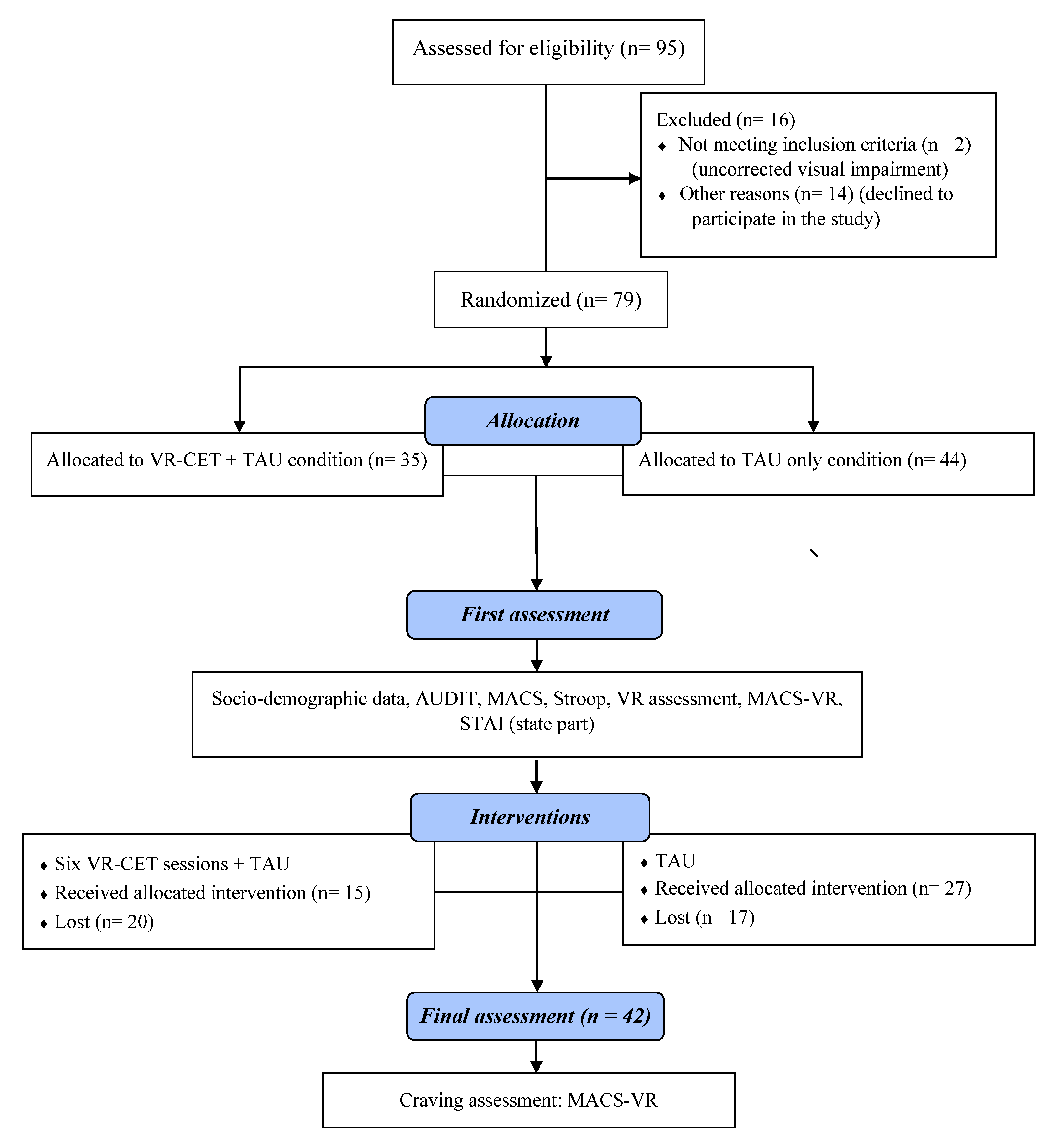
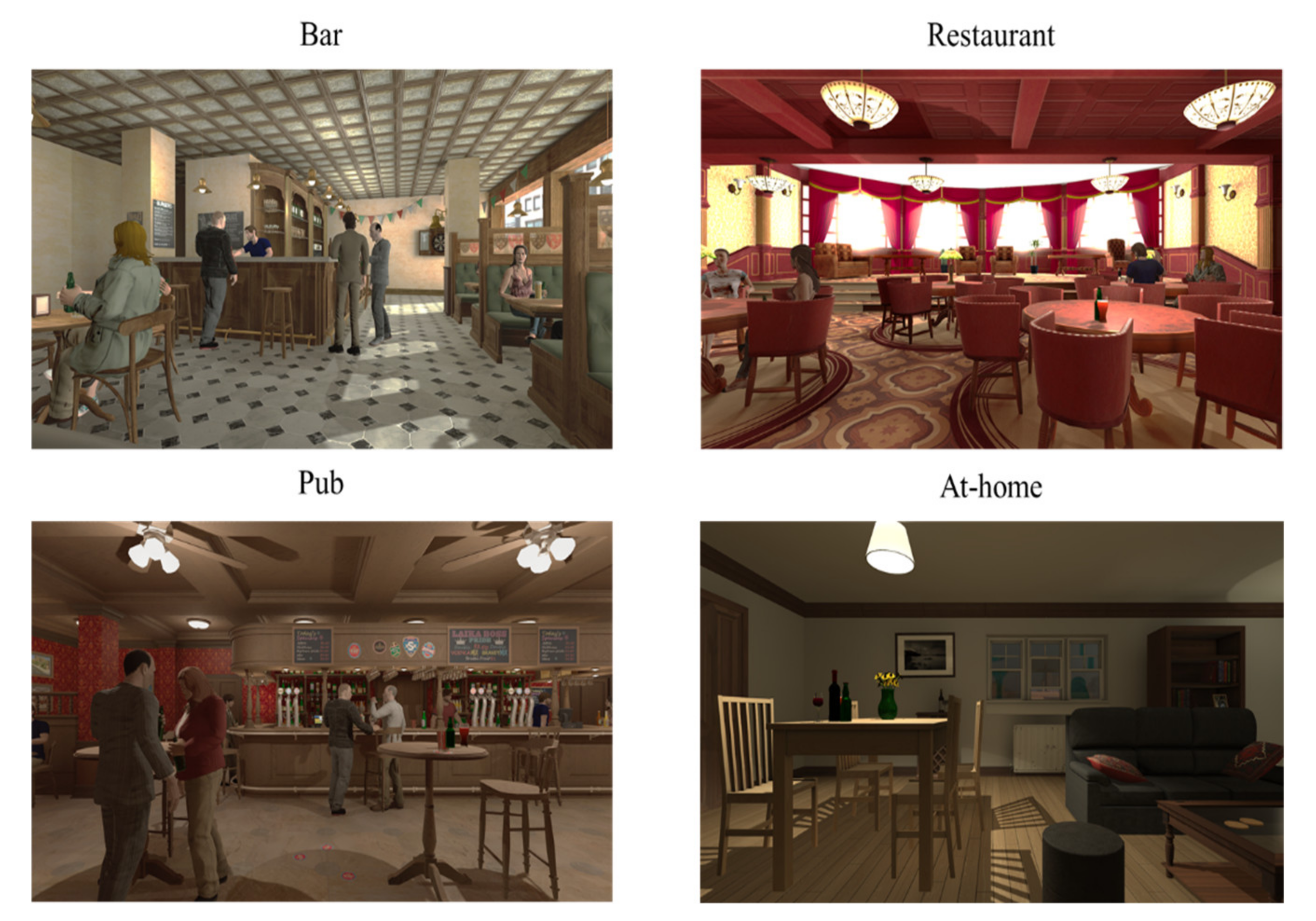
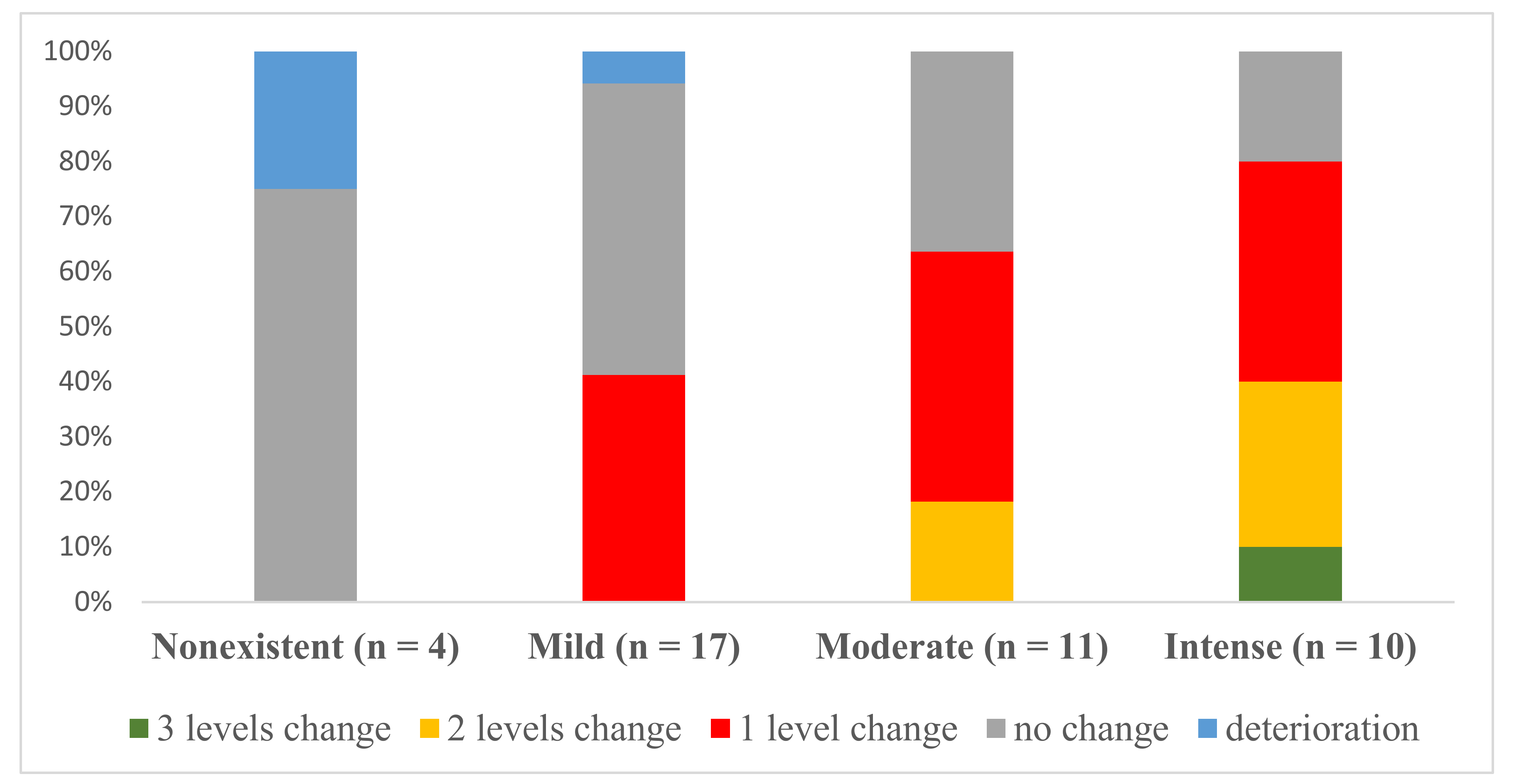
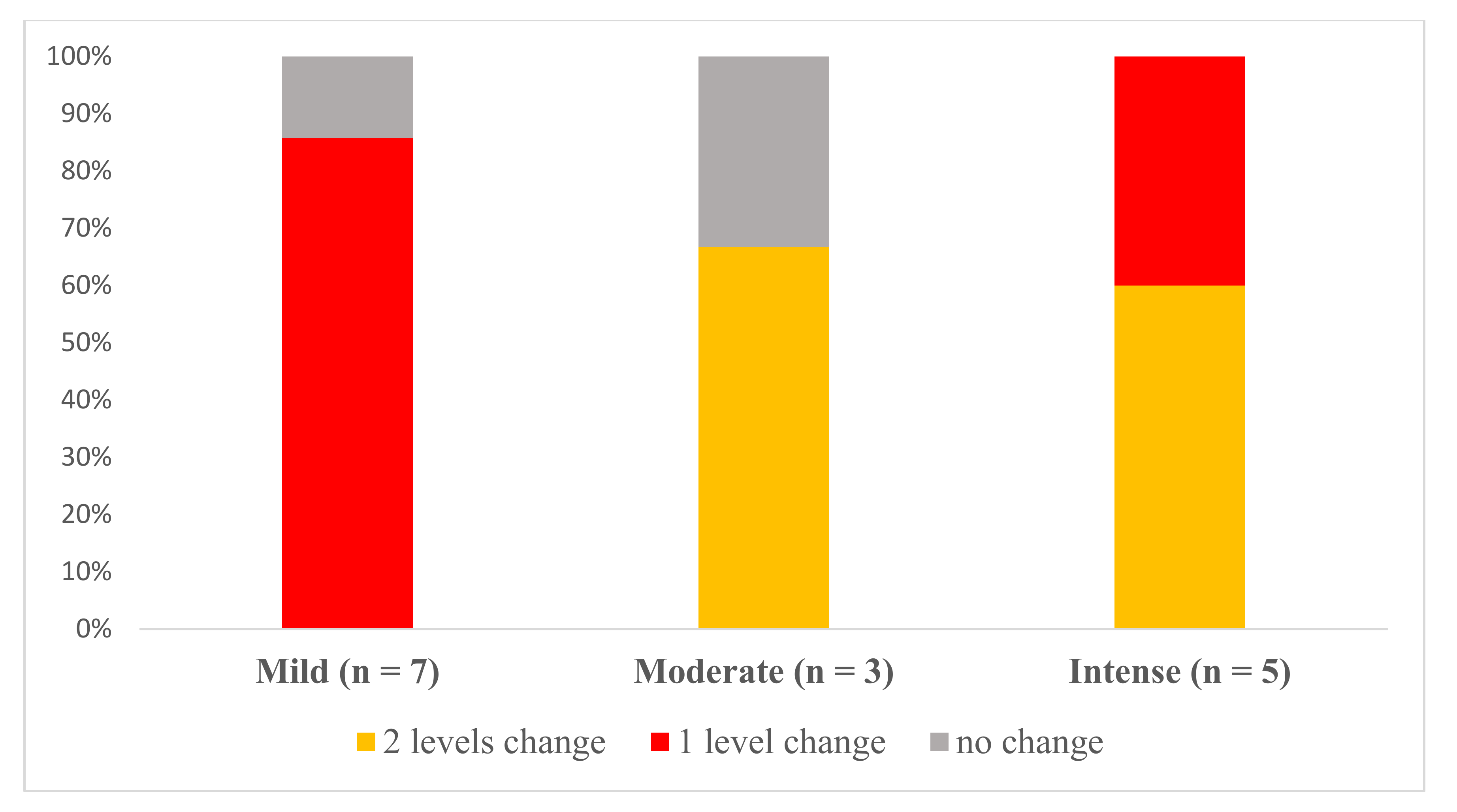
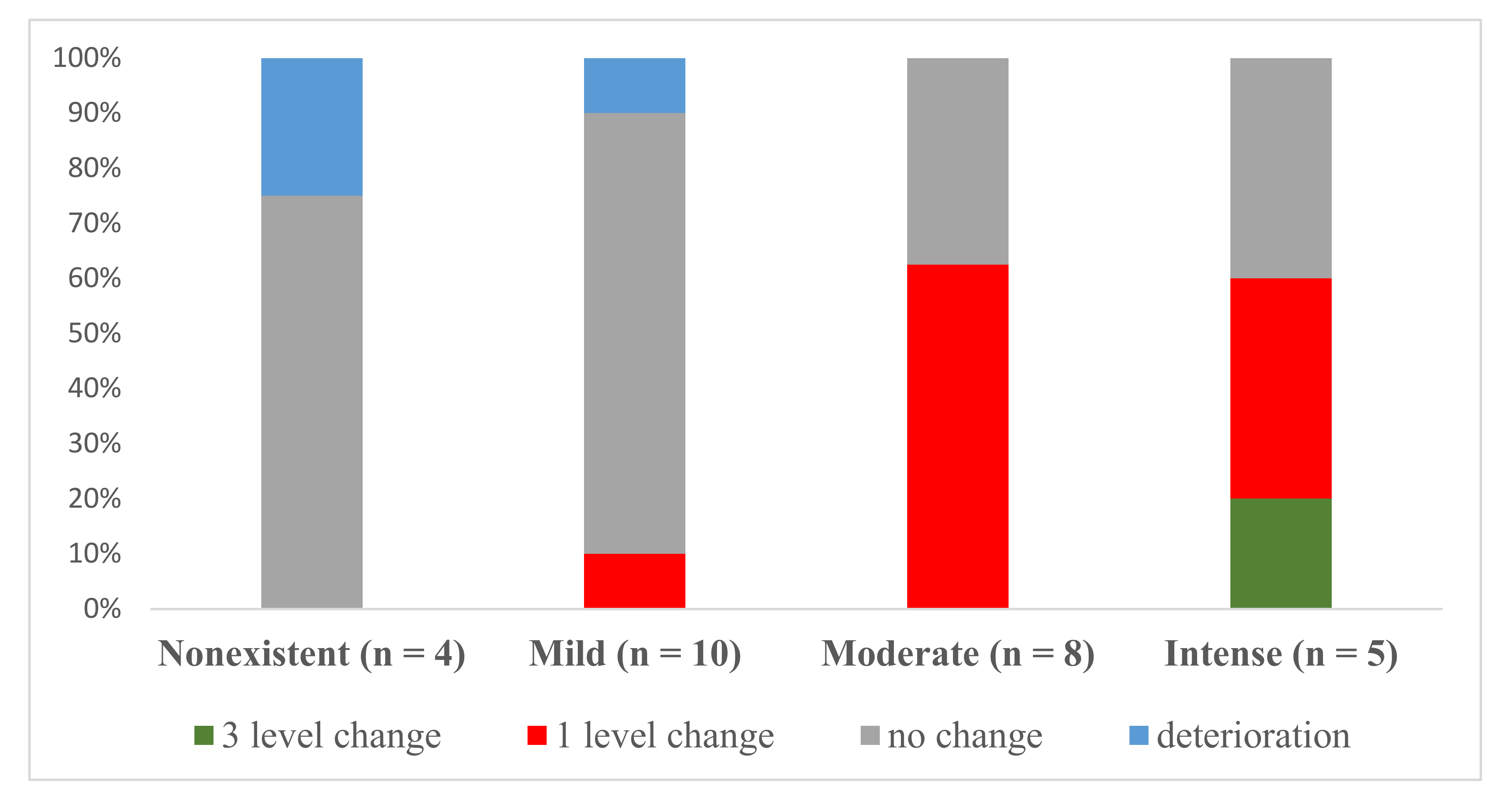
| N (%) or Mean ± SD | N or Mean ± SD | Comparison TAU vs. TAU+VR-CET | |||
|---|---|---|---|---|---|
| Characteristics | Total Sample (n = 42) | Improvement in AC (n = 22) | No Change or Deterioration (n = 20) | p Value | p Value |
| Age | 54.60 ± 7.71 | 52.91 ± 7.74 | 56.45 ± 7.42 | 0.474 | 0.576 |
| Gender (female) | 21 (50.0%) | 13 | 8 | 0.354 | 1.000 |
| Education | 0.617 | 0.657 | |||
| Elementary school | 0 (0.0%) | 0 | 0 | ||
| High school | 17 (40.5%) | 9 | 8 | ||
| Junior college Associate degree | 9 (21.4%) | 6 | 3 | ||
| University | 15 (35.1%) | 6 | 9 | ||
| Master‘s degree | 1 (2.4%) | 1 | 0 | ||
| Socioeconomic status | 0.449 | 0.271 | |||
| Low | 6 (14.3%) | 4 | 2 | ||
| Medium | 35 (83.3%) | 17 | 18 | ||
| High | 1 (2.4%) | 1 | 0 | ||
| Civil status | 0.116 | 0.571 | |||
| Single | 5 (11.9%) | 1 | 4 | ||
| Married/in a relationship | 19 (45.2%) | 8 | 11 | ||
| Separated/divorced | 13 (31.0%) | 9 | 4 | ||
| Widower | 5 (11.9%) | 4 | 1 | ||
| AUD severity | 16.95 ± 9.96 | 18.55 ± 11.15 | 15.20 ± 8.40 | 0.068 | 0.572 |
| Abstinence duration (days) | 98.52 ± 113.72 | 93.95 ± 109.96 | 103.55 ± 120.38 | 0.975 | 0.538 |
| Psychiatric comorbidity | 22 (52.4%) | 11 | 11 | 0.746 | 1.000 |
| Types of psychiatric comorbidity | 0.133 | 0.199 | |||
| No comorbidity | 20 (47.6%) | 11 | 9 | ||
| DD | 12 (28.6%) | 3 | 9 | ||
| DD + AD | 2 (4.8%) | 1 | 1 | ||
| DD + AD + PD | 3 (7.1%) | 2 | 1 | ||
| AD | 2 (4.8%) | 2 | 0 | ||
| PD | 3 (7.1%) | 3 | 0 | ||
| State anxiety | 18.47 ± 11.37 | 18.40 ± 11.32 | 18.55 ± 11.72 | 0.710 | 0.326 |
| Attentional bias | 15.36 ± 13.15 | 13.36 ± 13.94 | 17.55 ± 12.20 | 0.560 | 0.491 |
| Current smoker | 25 (59.5%) | 15 | 10 | 0.546 | 0.531 |
| Use of Illicit drugs | 15 (35.7%) | 13 | 2 | 0.001 | 0.325 |
| Type of treatment | 0.001 | NA | |||
| TAU + VR-CET | 15 (35.7%) | 18 | 9 | ||
| TAU | 27 (64.3%) | 2 | 13 | ||
| Characteristics | B | O.R. (95%CI) | p Value |
|---|---|---|---|
| Type of treatment | −2.899 | 0.055 (0.008–0.386) | 0.004 * |
| Illicit drugs | −2.899 | 0.055 (0.008–0.386) | 0.004 * |
© 2020 by the authors. Licensee MDPI, Basel, Switzerland. This article is an open access article distributed under the terms and conditions of the Creative Commons Attribution (CC BY) license (http://creativecommons.org/licenses/by/4.0/).
Share and Cite
Hernández-Serrano, O.; Ghiţă, A.; Figueras-Puigderrajols, N.; Fernández-Ruiz, J.; Monras, M.; Ortega, L.; Mondon, S.; Teixidor, L.; Gual, A.; Ugas-Ballester, L.; et al. Predictors of Changes in Alcohol Craving Levels during a Virtual Reality Cue Exposure Treatment among Patients with Alcohol Use Disorder. J. Clin. Med. 2020, 9, 3018. https://doi.org/10.3390/jcm9093018
Hernández-Serrano O, Ghiţă A, Figueras-Puigderrajols N, Fernández-Ruiz J, Monras M, Ortega L, Mondon S, Teixidor L, Gual A, Ugas-Ballester L, et al. Predictors of Changes in Alcohol Craving Levels during a Virtual Reality Cue Exposure Treatment among Patients with Alcohol Use Disorder. Journal of Clinical Medicine. 2020; 9(9):3018. https://doi.org/10.3390/jcm9093018
Chicago/Turabian StyleHernández-Serrano, Olga, Alexandra Ghiţă, Natàlia Figueras-Puigderrajols, Jolanda Fernández-Ruiz, Miquel Monras, Lluïsa Ortega, Silvia Mondon, Lidia Teixidor, Antoni Gual, Lidia Ugas-Ballester, and et al. 2020. "Predictors of Changes in Alcohol Craving Levels during a Virtual Reality Cue Exposure Treatment among Patients with Alcohol Use Disorder" Journal of Clinical Medicine 9, no. 9: 3018. https://doi.org/10.3390/jcm9093018








